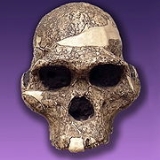
Australopithecus africanus
Overview
Australopithecus africanus was an early hominid
, an australopithecine
, who lived between 2–3 million years ago in the Pliocene
. In common with the older Australopithecus afarensis
, A. africanus was slenderly built, or gracile, and was thought to have been a direct ancestor of modern humans. Fossil
remains indicate that A. africanus was significantly more like modern humans than A. afarensis, with a more human-like cranium permitting a larger brain
and more humanoid facial features.
Hominidae
The Hominidae or include them .), as the term is used here, form a taxonomic family, including four extant genera: chimpanzees , gorillas , humans , and orangutans ....
, an australopithecine
Australopithecine
The term australopithecine refers generally to any species in the related genera Australopithecus or Paranthropus. These species occurred in the Plio-Pleistocene era, and were bipedal and dentally similar to humans, but with a brain size not much larger than modern apes, lacking the...
, who lived between 2–3 million years ago in the Pliocene
Pliocene
The Pliocene Epoch is the period in the geologic timescale that extends from 5.332 million to 2.588 million years before present. It is the second and youngest epoch of the Neogene Period in the Cenozoic Era. The Pliocene follows the Miocene Epoch and is followed by the Pleistocene Epoch...
. In common with the older Australopithecus afarensis
Australopithecus afarensis
Australopithecus afarensis is an extinct hominid that lived between 3.9 and 2.9 million years ago. A. afarensis was slenderly built, like the younger Australopithecus africanus. It is thought that A...
, A. africanus was slenderly built, or gracile, and was thought to have been a direct ancestor of modern humans. Fossil
Fossil
Fossils are the preserved remains or traces of animals , plants, and other organisms from the remote past...
remains indicate that A. africanus was significantly more like modern humans than A. afarensis, with a more human-like cranium permitting a larger brain
Brain
The brain is the center of the nervous system in all vertebrate and most invertebrate animals—only a few primitive invertebrates such as sponges, jellyfish, sea squirts and starfishes do not have one. It is located in the head, usually close to primary sensory apparatus such as vision, hearing,...
and more humanoid facial features.
Unanswered Questions
Discussions

